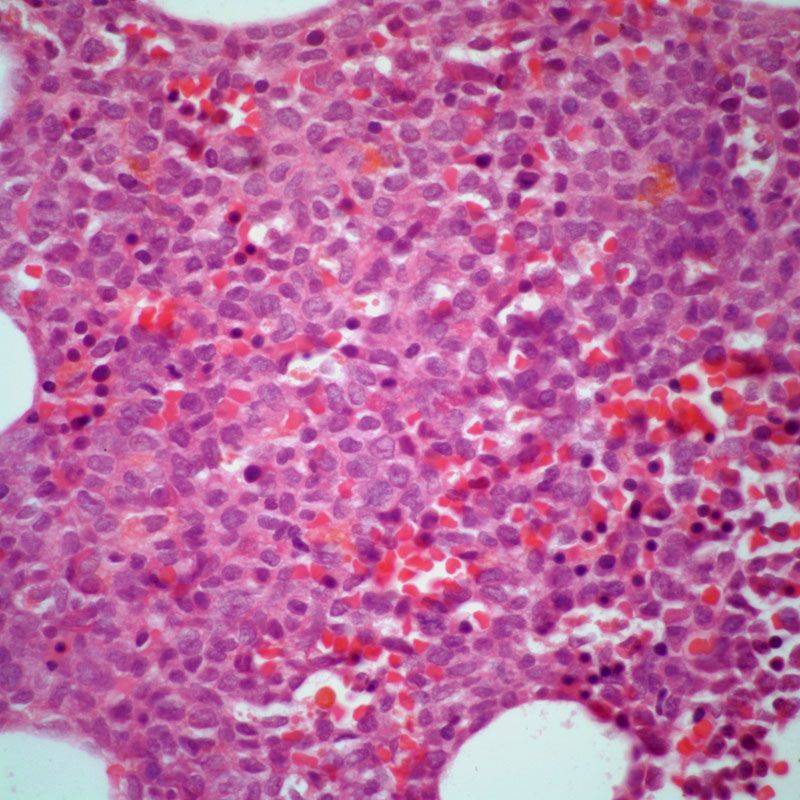Gilteritinib Appears to Yield ‘Encouraging Responses’ in Newly Diagnosed FLT3-Mutant AML
The experimental agent appears tolerable in patients with newly diagnosed FLT3-mutated acute myeloid leukemia in a phase 1b trial.
"These encouraging response and survival rates suggest that no apparent harm resulted from the longer periods of aplasia observed in this study and will hopefully be reproduced in ongoing pivotal studies involving gilteritinib," according to the authors of the phase 1b 2215-CL-0103 trial (NCT02236013).

Gilteritinib (ASP2215; Xospata) in combination with intensive induction and consolidation chemotherapy and as single-agent maintenance therapy conferred clinical benefits in patients with newly diagnosed FLT3-mutated acute myeloid leukemia (AML), according to findings from the phase 1b 2215-CL-0103 trial (NCT02236013).
After a single induction cycle, the composite complete response (CR) rate was 89%, and 83% of patients had conventional complete responses. The median overall survival (OS) was 46.1 months. The median time to count recovery during induction was approximately 40 days, and investigators noted that longer time to count recovery correlated with higher trough levels of gilteritinib that were associated with azole usage.
Of the 58 patients evaluable for response, 31 were alive after a median follow-up of 36.7 months. In sum, 72% of patients with FLT3-mutant disease underwent hematopoietic stem cell transplant (HSCT) during or after study therapy vs 14% of those with FLT3 wild-type disease.
The OS rate at 4 years was 59% among patients 60 years old and younger with FLT3-mutant disease. The median event-free survival (EFS) was 0.6 months with a 42-day cutoff for count recovery across the 36 evaluable participants with FLT3 mutations compared with 16 months with a 56-day cutoff.
“Gilteritinib was very tolerable as most planned study doses were administered and only [4 patients] on maintenance therapy after HSCT discontinued because of nonrelapse adverse [effects],” the investigators wrote. “These encouraging response and survival rates suggest that no apparent harm resulted from the longer periods of aplasia observed in this study and will hopefully be reproduced in ongoing pivotal studies involving gilteritinib. However, any interpretation of EFS results for trials with gilteritinib incorporated into chemotherapy regimens should take into account that there will be a longer recovery time from aplasia.”
This multicenter trial included a dose-escalation and dose-expansion phase. A total of 80 patients were assigned to treatment between January 2015 and December 2019, 79 of whom received at least a single dose. Fifty-eight patients received treatment in parts 2 through 4 of the study; investigators assessed dose expansion and alternate induction regimens during this time.
The median age of these patients was 59 years old (range, 24-77). A minority (36%) of these patients were female, and 47% had an ECOG performance status of 1, with a further 36% having a status of 0 and 17% having a status of 2. Most patients had disease of intermediate cytogenetic risk (86%).
During part 1, patients were assigned to cohorts in a 3+3 fashion, with gliteritinib dosages including 40 mg, 80 mg, 120 mg, and 200 mg once a day to determine the maximum tolerated dose (MTD). Patients received intravenous idarubicin at a dose of 12 mg/m2 once per day over 15 minutes on days 1 through 3, as well as cytarabine at 100 mg/m2 once per day as a continuous infusion on days 1 through 7 during remission induction.
Part 2, the expansion phase, was designed to assess the MTD from part 1. Part 3 was designed to assess an alternative anthracycline and gilteritinib schedule, and part 4 assessed the effect of continuous gilteritinib exposure during consolidation therapy. Maintenance therapy consisted of gilteritinib daily for 28-day cycles up to a maximum of 26 cycles.
The study’s primary end points were dose-limiting toxicities (DLTs) and MTD in this treatment setting, and the secondary end point was pharmacokinetics.
Two DLTs—delayed count recovery and reduced ventricular ejection fraction—affected a single patient in part 1 of the study; investigators deemed both events were attributable to toxicity caused by excess anthracycline exposure. Additionally, 2 of 3 patients who received the study agent at the 200 mg dose level developed DLTs: fatal neutropenic colitis and delayed count recovery.
“Randomized comparisons of gilteritinib vs midostaurin combined with chemotherapy are underway,” the investigators concluded.
Reference
Pratz KW, Cherry M, Altman JK, et al. Gilteritinib in combination with induction and consolidation chemotherapy and as maintenance therapy: a phase IB study in patients with newly diagnosed AML. J Clin Oncol. Published online June 28, 2023. doi:10.1200/JCO.22.02721